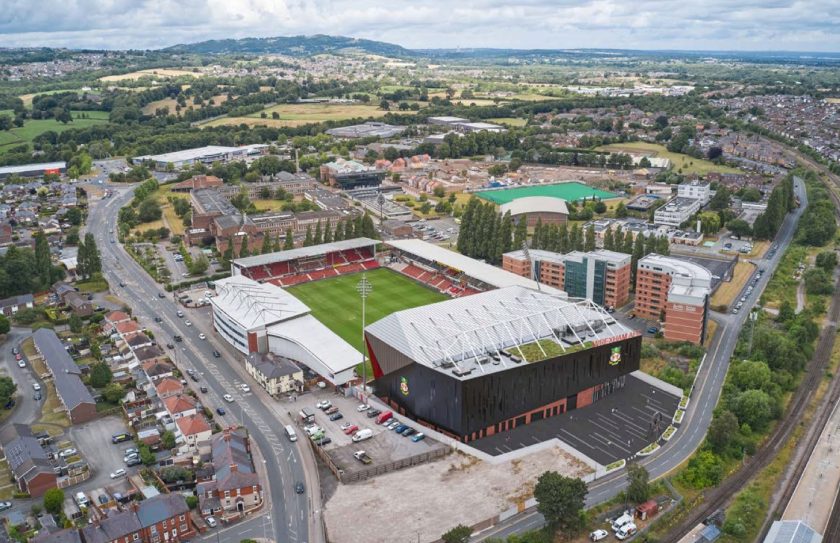Kop redevelopment set for approval but could phosphates restrict non-matchday use of new stand?

Council officers have recommended plans to create a new 5,500-seat Kop at Wrexham AFC’s Racecourse Ground should be approved.
However, it will be left up to councillors to decide if hospitality facilities within the new stand can be used outside of match days.
The delivery of a replacement for the dilapidated old Kop was one of the key pledges made by the club’s owners Ryan Reynolds and Rob McElhenney when they took over in February 2021.
The final report that will be put before members of Wrexham Council’s planning committee is now public, with a recommendation that the development should be granted.
But long-standing phosphates issues which we have documented affecting planning applications in the area, and across Wales, could impact on the new Kop.
Phosphates are naturally occurring minerals which can enter rivers via land management practices, sewerage and foul water, causing significant ecological damage.
Environmental regulator Natural Resources Wales (NRW) has introduced phosphate control regulations to protect watercourses in Special Areas of Conservation (SACs) across the country.
The Welsh Government said phosphate pollution poses a “serious risk” to health and must be addressed.
As we previously reported, the latest technical update on the Kop development appeared to mitigate any phosphate issues, with it stating the plans would have a ‘negligible impact’ upon existing phosphate levels.
The formal report before councillors highlights an interesting argument that will also likely provoke a discussion on parking.
It notes the existing Kop could be theoretically be refurbished without planning permission being required and therefore have 5,000-odd people using it on match days, without having to change the existing arrangements on either parking or phosphates. It states:
The fallback position of the existing Kop stand and the potential for it to be refurbished and re-used without the need for planning permission means that in terms of match day spectator capacity, the development would not facilitate a material net increase in the numbers of people on-site (and therefore would not result in a net increase in foul water discharges from the site).
Match day use of the new Kop is therefore unlikely to result in an increase in waste water or phosphorous volumes. Accordingly it is reasonable to conclude that match day use will not adversely impact upon the SAC, having regard to the comparable impact that would occur if the existing Kop was brought back into use.
However, according to officers, the Welsh Government has “…recently informally expressed some reservation about the robustness of such an approach, suggesting that if Wrexham Association Football Club was to be promoted at any time in the future, standing areas could not be used, whilst seating is required for international football. It should be noted that some standing is allowed at lower football league clubs, whilst at this point in time, hosting senior international football matches is not guaranteed.”
The Welsh Government suggested an alternative approach where it would acknowledge that the proposed development “could result in a small increase in foul water discharges”.
It said the justification for granting planning permission would be for “imperative reasons of overriding public importance i.e. the regeneration and place shaping benefits.”
Use of the stand outside of matchdays for hospitality or exhibitions could be a bone of contention though.
The report states: “The proposed development increases the potential for the Racecourse to be used on non-match days and to increase the foul water discharges from the site as a result of those events.
“Non-match day use of the Kop would be likely to increase the volume of phosphorous entering the River Dee SAC and in turn, has the potential to adversely impact upon the SAC.
“It is considered that the use of the event/exhibition space and the hospitality facilities on non-match days may need to be restricted until such time as this matter is satisfactorily resolved.”
In the formal conclusions from the planning officer, councillors are advised of the above ‘fallback position’ and discussion.
Subject to the outcome of a further consultation with NRW, they suggested a planning condition could be necessary to restrict the use of the stand until a phosphorous mitigation scheme can be agreed.
The document also reveals some other feedback, notably from Wrexham Glyndwr University (WGU), who currently have an active application going through the planning system for student flats in very close proximity to the proposed new Kop.
The university previously indicated that all was well after the potential crossover of land earmarked for the two developments was highlighted.
It said in a statement the football club was “aware and supportive” of its plans to create a large new student apartment complex with 197 beds. At the time a university official said both schemes would be able to go ahead without impacting one other.
However, in submissions made as part of the Kop application, it now says the development would render the latest part of the student village scheme “undeliverable”.
It said a smaller block could be built, but this would not achieve the same number of beds and would represent a “compromised form of development.”
It adds: “WGU require a commitment that alternative opportunity will be facilitated for the build of additional student accommodation on or in close proximity to the university campus.
“This could be secured through the appropriate use of planning conditions (pre-commencement and/or Grampian) or unilateral undertaking.
“Whether this commitment is secured through WAFC’s application, or alternatively through the Wrexham Gateway Partnership, is open to negotiation.”
The new documents do not detail why the university has changed its mind on whether both schemes can be delivered without impacting one another.
It has also not been detailed why the boundary issue was not spotted earlier, given the partnership including the university, football club and council has been working together on wider plans for the Mold Road gateway into Wrexham for several years.
Councillors are told that such issues are likely outside their remit, “Given that the implementation of a new Kop stand in the form proposed by this application relies on land within the University’s ownership, it is a private matter for Wrexham AFC and the University to reach an agreed position regarding the use or sale of the land as well as alternative options for the delivery of student accommodation.”
The university has also raised concerns over parking in relation to the new Kop, with officials pointing out that they only currently offer a limited amount of parking spaces on the Plas Coch campus to supporters via the Wrexham Supporters Association and would not accommodate coach parking for the new development.
The university is also looking to pass over responsibilities on previously imposed planning obligations on who should deliver improvements to the junction of Crispin Lane and Mold Road junction. University officials argue financial responsibility should fall to the wider Wrexham Gateway Partnership and that any other highways improvements should also be tied to the Kop redevelopment.
Parking issues are also noted from Offa Community Council, with a summary of their feedback and requests noted “…that on match days, the existing current level of additional on-street parking is putting enormous pressure on local residents in the immediate vicinity of the grounds. Suggests that a residents’ parking scheme is required to be delivered preferably outside of the planning process and if this is not achievable then it should be conditioned as part of any planning approval.”
Councillors have also been reminded of the ‘special’ status of the Kop plans in the committee report.
It states: “The redevelopment of the Kop at the Racecourse is a key element of the Wrexham Gateway Project.
“The proposed development would deliver a state-of-the-art spectator stand in place of the old stand and includes enhanced hospitality provision.
“The development would enhance the facilities available for supporters watching Wrexham AFC matches but would also improve the ability of the Racecourse Ground to hold other football and sporting events as well as non-sporting events.
“The effect would raise profile of the football club but also the city of Wrexham itself. In addition to the hospitality facilities, the ground floor space of the proposed new Kop could be used for event/exhibition space on non-match days.
“Finally, the proposal would deliver a ‘landmark’ building that would enhance the appearance of the existing Racecourse and the surrounding area, particularly when viewed from Mold Road and approaches to the city by rail from the north.”
As keen watchers of planning meetings over the years, Wrexham.com readers will know the committee will often draw their own conclusions and decisions, but they are advised to grant planning permission and give power to the Chief Planning Officer at Wrexham Council to resolve the phosphates issue and add or amend conditions accordingly.
You can read the full document here and watch the meeting live online via webcast at 4pm on Monday (7th November).
Be warned, there is also an application on the agenda about a quarry extension in Llay in relation to which councillors have already held two meetings and a site visit without making a decision, so if you are tuning it the Kop might be heard in the second half, or even extra time depending on how the Chair manages business on the evening.
Crispin Lane Planning Conditions From History
The value of planning conditions in Wrexham has previously appeared to be a dubious matter.
Wrexham Council’s planning committee famously took a failed ‘gamble’ by backing the football club’s former owners Geoff Moss and Ian Roberts with their student flats development by the Kop.
Requirements included that: “within six months of the first use of the development, trees and shrubs shall be planted on the site in accordance with a scheme which has been submitted to and approved by the local planning authority”.
It went on to state that “any trees or shrubs removed, dying, being severely damaged or becoming seriously diseased within five years of planting shall be replaced by trees or shrubs of a similar size and species to those originally required to be planted”.
Did that happen? We have previously documented the complete lack of care from Wrexham Council, republished below for old times’ sake to answer that question…

Spotted something? Got a story? Email [email protected]












